In which a writer and critic goes back to class
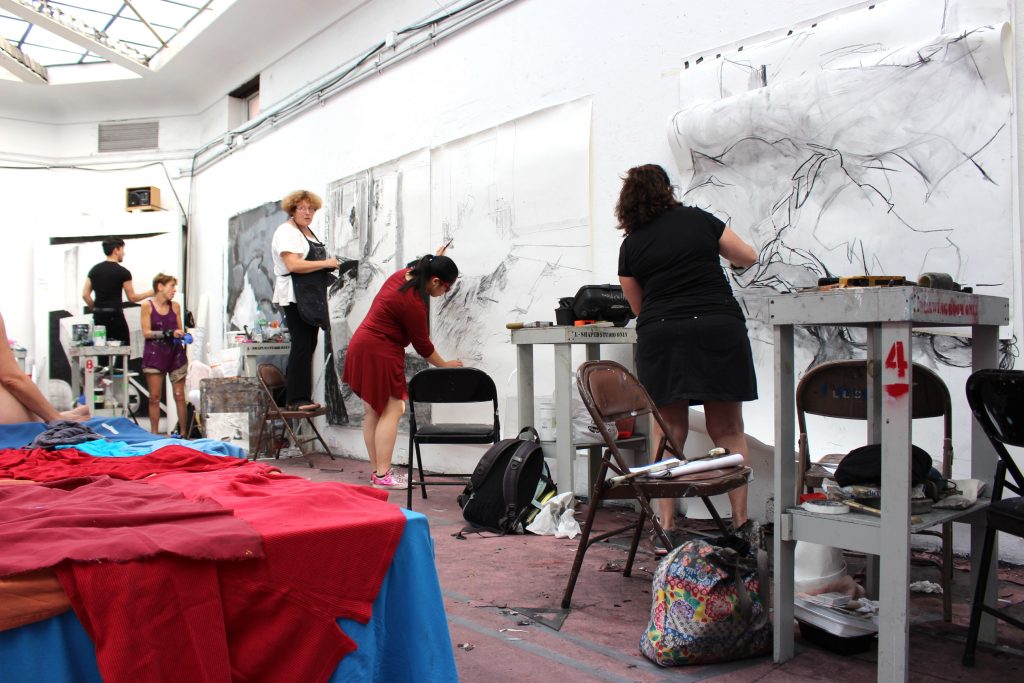 Please note that this story is reprinted from the ARTnews issue of October, 1995. But 20 years later, the New York Studio School “drawing marathons” still continue along the same lines, under the expert guidance of the school’s dean, Graham Nickson.
Please note that this story is reprinted from the ARTnews issue of October, 1995. But 20 years later, the New York Studio School “drawing marathons” still continue along the same lines, under the expert guidance of the school’s dean, Graham Nickson.
When I was a child, I drew compulsively—on the backs of envelopes, shopping bags, any available blank surface. My mother finally tacked brown butcher’s paper along the walls of my room to save the paint job. In college I was briefly a fine-arts major, before deciding that I would rather look at art than make it. I was also impatient: I wanted to be Helen Frankenthaler with none of the growing pains between Life Studies 101 and critical acclaim. So I switched to art history. It was time to get serious.
Through the years, however, I’ve enrolled in many drawing classes. These were mostly straightforward offerings in the venerable academic tradition: students draw from a model, while the instructor moves around giving pointers. After four or five sessions I’d usually quit, disgusted that I couldn’t produce anything resembling even the most casual sketch by Degas or Matisse.
When ARTnews offered me the chance to participate in and write about my experiences in a two-week drawing “marathon” at the New York Studio School, I accepted with alacrity (hey, two weeks out of the office!), tinged with skepticism (I can’t draw worth a damn, and never will.)
The school, founded 50 years ago, is one of the few art academies in the country to eschew commercial and liberal-arts courses in favor of a solid grounding in sculpture, drawing, and painting. The drawing class was developed by Graham Nickson, a figurative artist who shows at Betty Cuningham Gallery in New York, and it incorporates, as he says, “the fundaments of teaching in the way I would like to have been taught.” For ten long days, students draw from nine in the morning till six in the evening and then participate in critiques that last until 7:30 or 8:00 P.M. Each night, I returned home, crawled into the bathtub, and cursed my editors. I can’t say that by the end of the course my drawing improved particularly, but I lost three pounds and developed renewed respect for artists—and best of all, acquired a fresh set of eyes.
Herewith a diary of my two-week marathon.
Sixty-three students assemble in four studios in the original Whitney Museum building on West Eighth Street. In each studio is an elaborate “set-up,” a draped and tented structure that looks like an Arab chieftain’s headquarters from a B movie—ficus trees and potted palms at the sides and comers, three or four male and female models seated on stools, standing, or reclining in the tent. “We’ve gone to a great deal of trouble to assemble this set, so please use the whole thing,” says Nickson, a formidably articulate Englishman.
For the first two hours, he tells the class, he gives no instructions because he wants to see how each student draws. I choose to focus on a plump, fair-skinned young woman seated on a stool and plunge in in my usual haphazard fashion: try to make sense of the head, the shoulders, the buttocks, the legs—the whole confusing welter that is a real live human being.
At the eleven o’clock break, we pin our drawings to the walls of an adjacent studio, and Nickson lectures us: “This is a class about perception, not about style. It’s about the eye traveling through space, seeing where form exists and where it doesn’t. Drawing is not occupational therapy.” He stresses the importance of recognizing the shape and size of the paper and talks about “positive” and “negative” space (objects and the gaps between them); “connections” (how the visible world hooks up); and the “integrity of the rectangle.”
After the break, I start to think more about the whole paper, balancing the model by adding the draped pot of fems and sketching in another student. At first I think I’m getting a nervous, Pascin-like quality; by the end of the morning—oh, such hubris!—I’m seeing echoes of Diebenkom and Matisse.
Later Nickson tells me, “You’re drawing esthetically, you’re not drawing the experience. What you’re doing is making a shopping list-you’re not observing the connections between things.”
For the rest of the afternoon, we work on different exercises, starting with the closest object to our field of vision, moving to the farthest. The last drill of the day: draw a vertical strip one-inch wide and include every thing you see in that space.
At the critique that evening, Nickson asks us the point of the “strip drawing.” One student mumbles something about looking for relationships. “Exactly,” says, Graham. “Too many people are falling into the trap of listing. A successful drawing makes you think about where the person was in relationship to making it.”
More strip drawings: one-inch wide on the vertical, the horizontal, the diagonal, graduallyadding information until a coherent whole begins to appear. I think I’m getting the point—look for relationships among the components instead of beginning at the center and working outward. Nickson tells us, “It’s crucial to think about the marks you make as evidence of where you’ve traveled.” He also emphasizes the importance of correcting: “It’s the lifeblood of the drawing.”
By noon, the heat in the studio is nearly unbearable. My neighbor drapes paper towels soaked in cold water around her neck. I joke about “spa drawing”: Why pay to hang out at a pricey retreat when you can lose a few pounds and learn to draw at a fraction of the cost?
After lunch we start a new drawing on a five-by-five-foot sheet of paper. Satisfied with the figure I’ve sketched, I start coloring in a piece of drapery: “You’re doing that because you don’t know what what else you should be doing,” Nickson scolds. “You should be looking at the relationships between the different forms.” Cranky and discouraged, I leave early.
But on the subway, I can’t look at the folds of people’s clothing without wanting to draw what I see.
DAY THREE
After an hour of working on the big drawing, we’re told to mark off a rectangle in the center and just correct that space. “Look for intervals between things. Draw a bit of the arm, a bit of the cloth, and so on.” We gradually widen the rectangle of the drawing, correcting again and again.
Around three, Nickson tells me he sees “a little bit of form” beginning to emerge on the right Then he shows me a diagram of how the forms should “read”: leg in front of the drapery, toe at the front of the foot. Each plane has a different tonal value. I see it, but I don’t see it.
Late in the afternoon, Nickson tells us to use tape to mask out five crucial areas that lead the eye into space, that are critical for reading the drawing. “We’re actually breaking the system here because we’re saying that there are some elements that are more important than others.” He points to the plant stand in my drawing: “This is absolutely crucial because it’s nearest the viewer. You must make it stronger, make it come for ward.” How do I do that?
“You’ll will it to be that way.” He smiles. When I take the tape off—Eureka!—there is depth and shadow and shape. The forms jump out at me.
During the critique, I am amazed at how different all the works are. There’s one of a languorous reclining male nude that conveys a real feeling of heat and lassitude. It’s imbued with emotions the others lack, but Nickson focuses on the strange flipping of space in the work.
This is not a class where value judgments are made. Nor is the evocation of mood a goal. Instead we’re groping for an experience of forms.
Later I spend an hour at the Edward Hopper preview at the Whitney. Yes, yes, I appreciate the atmosphere of melancholy and the aura of alienation, but all I can focus on is how clumsy his figures are. The guy seated on the steps in Sunday Morning seems about to keel forward; one of the woman’s breasts in South Carolina Morning is absurdly larger than the other. Hopper had a better·feel for the character of buildings than for that of the human body.
DAY FOUR
At around ten we get new models, new poses. We make 20 marks, spatial references, in a minute, then spend 20 minutes making the drawing. After that, Nickson tells us to move everything in the picture five inches to the right.
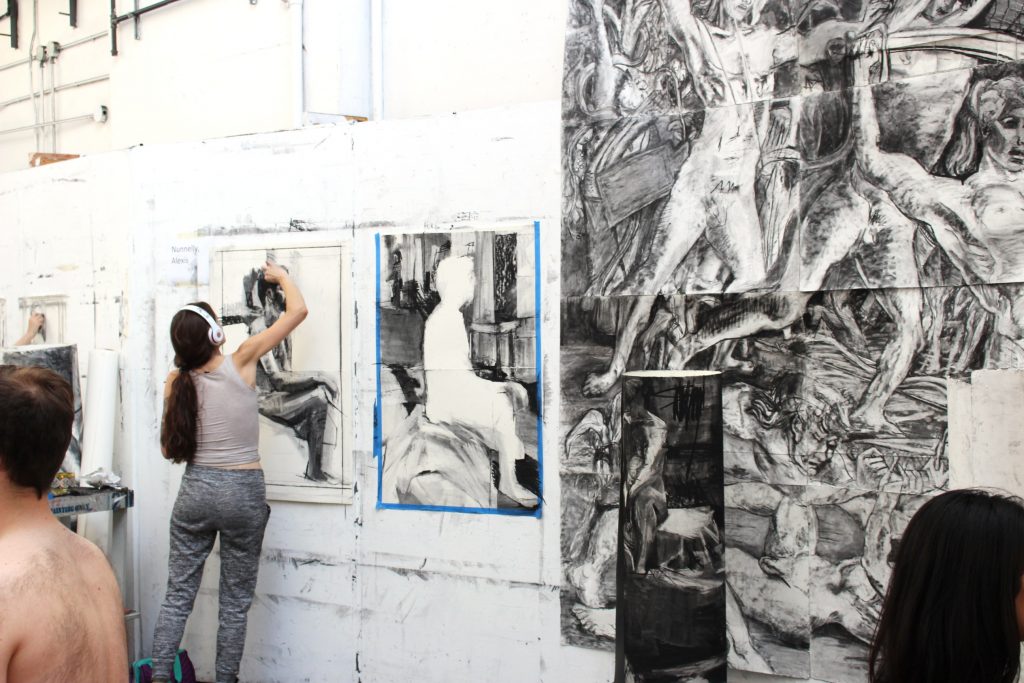 By 11A.M., the model seems about to pass out, and so am I. Sheepishly excusing myself, I spend the afternoon in bed.
By 11A.M., the model seems about to pass out, and so am I. Sheepishly excusing myself, I spend the afternoon in bed.
That evening, my eye falls on a reproduction of Whistler’s Variations in Flesh Colour and Green: The Balcony. I see the three women as shapes and spaces; I feel the distances between them as I never had before. Is this how the artist saw his models—not as three women, but as forms tied by intervals?
DAY FIVE
In the half-day I missed, the rest of the class has moved on to painting. I feel cheated, as though someone had started the Renaissance while I was still working on an illuminated manuscript. The drill today is to cover a 50-by-60-inch sheet of paper with a light-gray wash, then make 20 reference marks on the paper. Fill in five negative spaces with white, five positive spaces with black. Then find five negative spaces within the positive spaces. (Got that?) I’m working very, very slowly.
In the afternoon, we continue using thewhite paint to find the negative spaces. “All the black should begin to disappear.” Nickson takes the brush from me and boldly redefines the figure. “This looks too much like a woodcut.” By five o’clock I think I’m starting to get with the program. “Keep trying to find the big forms within the rectangle,” he says.
That evening, we compare the previous day’s drawings with today’s paintings. Everyone is doing simpler, bolder work: lights and darks jump out. Many of the “painted” drawings have an expressionist vigor, a confidence. And everyone is paying greater attention to the whole paper.
Over the weekend, I weigh myself: I have, indeed, sweated off two and a half pounds.
DAY SIX
We have a new set-up. Same tent, same models. But lots of stuff strewn about: tables, pitchers, vases, screens. I long for a simple flower in a bud vase.
Spend the whole morning on a 22-by-22-inch drawing. Some of the lessons are starting to sink in: correct obsessively; look for relationships; don’t draw clichès.
In the post-lunch critique Nickson says, “We’re on a quest for the power of the image. So far, these still look like drawings. The moment the work looks like an experience, something very different begins to happen.” Return to the easel. Correct all mistakes. After half an hour, I want to rub the whole thing out. Why would anyone want to be an artist?
We’re back to strip drawings, marking the farthest point in blue, the nearest in red, imposing ever more verticals and horizontals. We keep going over the same five drawings. I’m feeling the kind of confusion that comes from visiting a foreign city without a map.
In late afternoon we work on a big drawing, five-by-five feet. The guy next to me is driving me crazy. His approach is a kind of stand-up, doo-wop, action drawing: he twirls to look at the set, twirls back to the paper, makes a mark, twirls again. Then he jumps up and down on a chair to reach the uppermost edges.
In the last hour ·we divide the drawings into horizontal thirds. Use red and blue pastels (to indicate near and far). For each two marks in the bottom third, make only one in the top. By 5:30, I have a nice flank and hip of the reclining nude and drapery that’s halfway believable.
On the subway home, I realize how powerfully social and cultural factors shape the way the eye takes in the world. When we walk down the street, we generally observe: elegant dress or nice figure, hoodlum or tourist. After a week and a half of drawing, these conventions break down. The sag of a drunk’s shoulder can be more compelling than the weJI-tailored torso of the yuppie bound for Wall Street.
DAY EIGHT
Continue on the big drawing in blue, red, and charcoal; then section the whole thing off into 16 spaces. Beginning in the upper left, work in a spiral toward the center. “Pay special attention to the lower right,” Nickson says, “because that’s the most important comer, the one artists often ignore.”All the class efforts are beginning to look stronger. Many of the works have a compelling, sometimes vertiginous, sense of depth–there are Jots of budding Anselm Kiefers in this group–but mine sticks on the surface, seeming to tip toward the viewer.
After lunch, Nickson tells me, “You’re getting silly again. Whenever you don’t know what to do, concentrate on negative and positive space.” Then we tape a fresh 40-by-40-inch square on top of the larger drawing, and work from the comers inward. Same with a 20-by-20-inch square.
Switch on TV news at night. See only fonns and intervals. No news.
DAY NINE
We’ve been working on the 40-by-40 for two hours, when Nickson says he’s disappointed in our progress. We’re instructed to trade drawings with another student and correct each other’s mistakes. I change places with a muscular, scowling woman. Her work, of a seated nude in the center foreground and part of a reclining figure in the middle ground, surrounded by tables, drapery, and other paraphernalia, has a believable sense of deep space. But the figures and shapes are somewhat ineptly realized. She has a broad, dramatic style, so I don’t tamper with it or try to imitate her approach, but simply adjust the proportions and aim for a more realistic line.
When I examine her corrections to my drawing, I find that she has completely reinterpreted what I’ve seen, imposing a better sense of space, yes, but my credible, delicately silhouetted figures are lost in a welter of furious marks and stormy cross-hatching. Okay, bitch , this is war. I make some serious–very serious–adjustments to her drawing.
After studying the works, Nickson says, “Every drawing has gotten 20 times better because of this exchange.”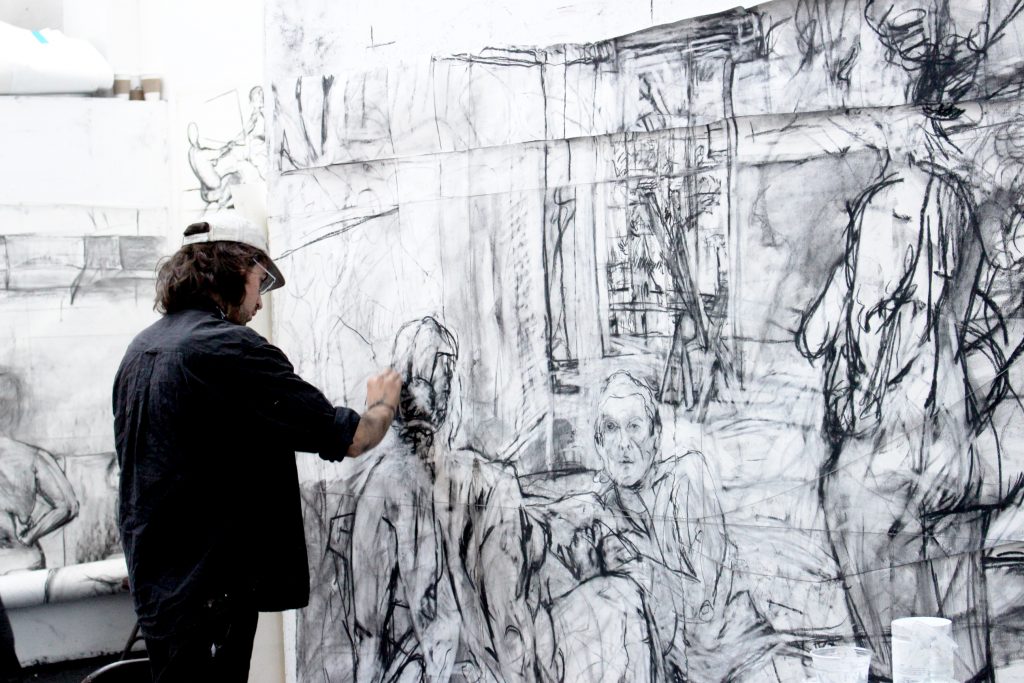
DAY TEN (LAST DAY!)
We continue with the smallest drawing (20 by 20 inches) from the day before, then gradually add strips of paper to the edges, building up the image from the center outward. I have a small section that almost pleases me–the torso, arms, and head of the model “sleeping” in the tent. Then I discover the arms are all wrong. Rub ’em out and start again.
In mid-afternoon, I pin up all my drawings for a final critique. This time Nickson is provocatively silent, regarding the works thoughtfully. He chooses several for a show of student work, including one I had forgotten about: a slice of male torso, framed by drapery and ferns, that is spontaneous, economical, almost mysterious. I feel absurdly proud.
By 4:30 I can draw no more. I think I’ve mastered some concepts, seeing the way things hang together. I’ve acquired a kind of skill that I can bring into play at will. When seated in a restaurant, for example, I can distance myself from a group of people and “mentally” draw what’s there. Whether I can put it on paper may be just a question of practice.
Curious to see Nickson’s own work, I later visited him in his studio and found large paintings and drawings of bathers at the beach, in isolation or disconnected groups. He juxtaposes vast empty spaces of sea and shore with classically realized figures, often obscuring their faces to subvert narrative readings.
I asked him the aims of the course. ”The class is not really about making a good drawing,” he explained. “Really what it’s about is that in two weeks you should come away experiencing the world in a very different and profound way.”
Yes, but why learn to draw in an age of video and mixed-media installations, when pushing art to the boundaries and beyond seems to be every young artist’s goal? “The extraordinary thing about drawing is that it’s the most direct, visceral possibility toward describing what you’re experiencing at the moment,” Nickson responded. “Besides,” be added, smiling. “What will you do when your video-camera breaks down?”
All photos courtesy of the New York Studio School
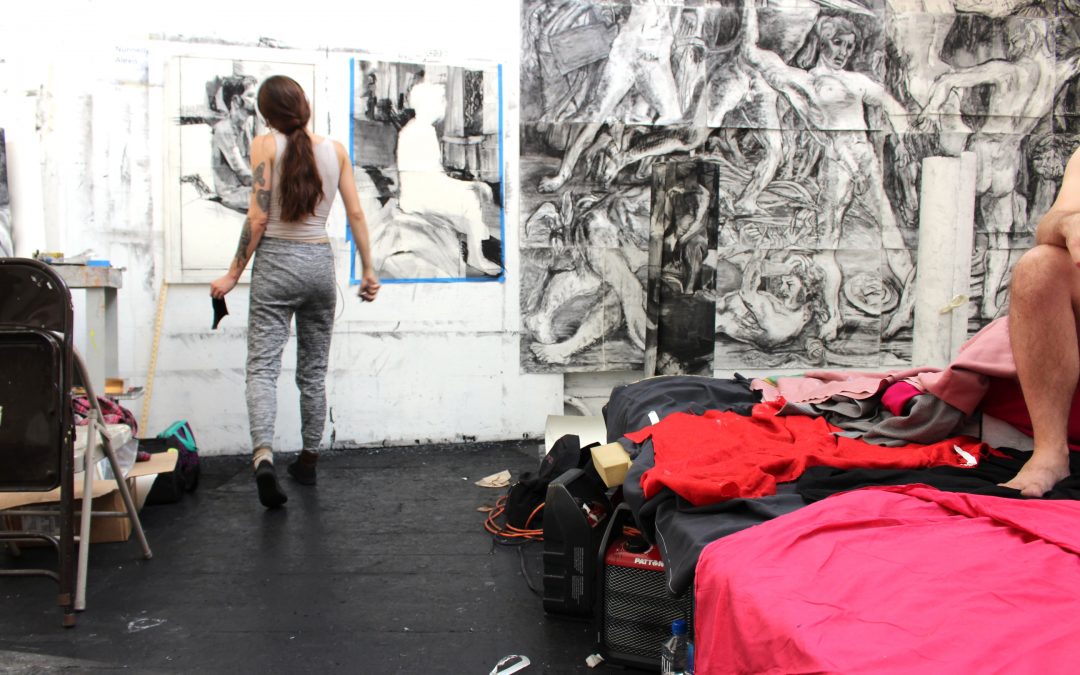
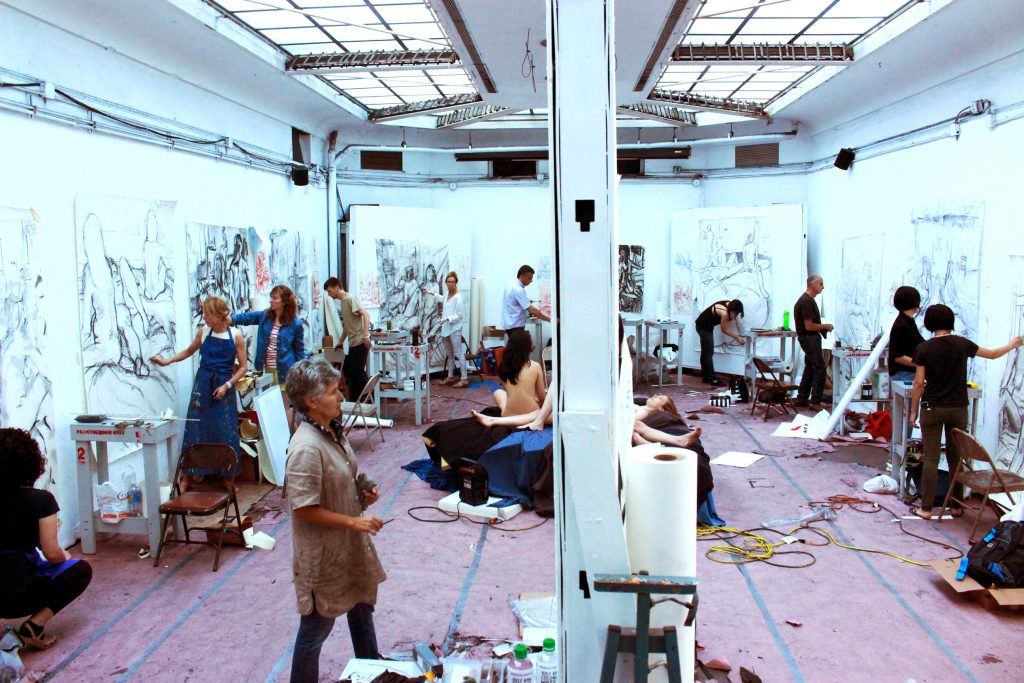
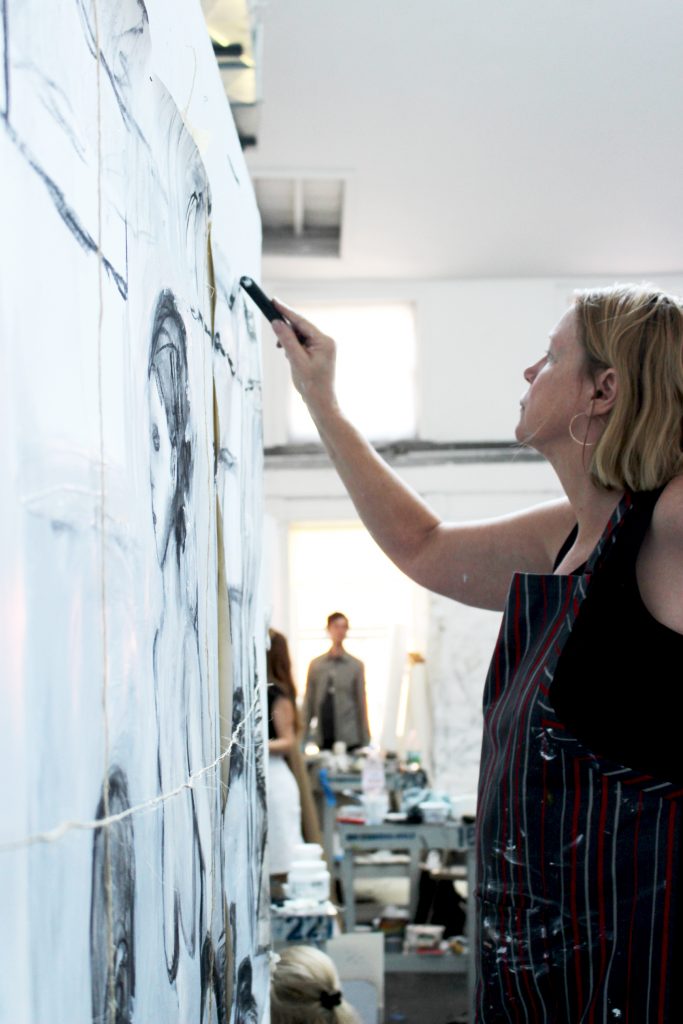
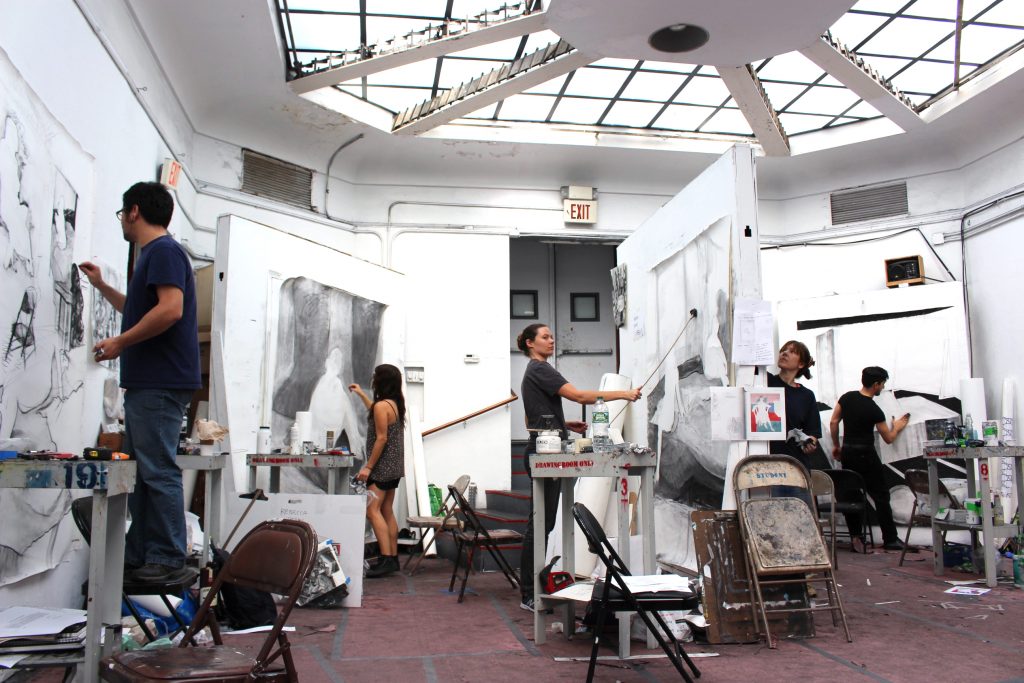
This is one of your best—-Thank You
A wonderful description of what is experienced in this workshop. Many of my friends have attended. I regret that I never participated in my younger, energetic years. Thank you for reposting.